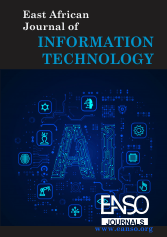Analysing Electronic Gadget Usage and Makerere University Engineering Student Performance
Abstract
Purpose: This study aims to investigate the relationship between electronic gadget usage and academic performance among Makerere University engineering students in Uganda. Methods: A structured five-item Likert-scale 10-item questionnaire was used to collect data from 618 students at Makerere University School of Engineering. Smart PLS-SEM was employed to assess the measurement and structural models, including reliability, validity, and path analysis. Results: The findings indicate that electronic gadget usage has a statistically significant positive effect on engineering student performance (β = 0.673, p < 0.001), explaining 45.3% of the variance in academic performance at a 95% confidence interval. Convergent and discriminant validity were confirmed, and the model met acceptable thresholds for composite reliability. Conclusion: Electronic gadgets are essential tools that can enhance academic performance if used strategically. Their widespread use among engineering students offers both opportunities and challenges for academic success. Institutions should promote responsible use through structured digital literacy initiatives. This study contributes to the body of knowledge on the electronic gadget usage and student performance, offering practical recommendations for educators and policymakers to enhance academic outcomes
Downloads
References
Bayanova, A. R., Kuznetsov, V. V, Merculova, L. V, Larisa, N., Pervozvanskaya, O. A., Shalamova, O. O., & Vorobyova, C. I. (2019). Student Performance Interrelation with Gadget Use at Lessons. 7(3), 432–437.
Bisen, S. (2016). An Analytical Study of Smartphone Addiction among Engineering Students: A Gender Differences. 4(1).
Bragdon, R. A. (2016). College Student Technology Use and Academic Performance. 6(1), 12–22.
Cohen, J. (1988). Statistical power analysis for the behavioral sciences (2nd ed.). Lawrence Erlbaum Associates.
Farooq, M., Ahmad, T. I., & Jahan, M. (2023). An Empirical Investigation of the Relationship Between Students’ Digital Consumption Time and Their Academic Outcome. 4(1), 1–9.
Hair, J. F., Sarstedt, M., Hopkins, L., & Kuppelwieser, V. G. (2014). Partial least squares structural equation modeling (PLS-SEM): An emerging tool in business research. European Business Review, 26(2), 106–121.
Ringle, C. M., Wende, S., & Becker, J.-M. (2020). Boenningstedt: SmartPLS GmbH. Retrieved from https://www.smartpls.com
Wong, K.-K. K. (2013). Marketing Bulletin, 24(1), 1– 32. https://marketing- bulletin.massey.ac.nz/V24/MB_V24_A01_Wong.pdf
Henseler, J., Ringle, C. M., & Sarstedt, M. (2015). A new criterion for assessing discriminant validity in variance-based structural equation modeling. Journal of the Academy of Marketing Science, 43(1), 115–135. https://doi.org/10.1007/s11747-014-0403-8
Johri, A., Tech, V., Teo, H. J., Tech, V., Tech, V., Schram, A. B., Tech, V., & Tech, V. (2012). AC 2012-3924 : Digital Engineers : Results Of A Survey Study Documenting Digital Media And Device Use Among Fresh- Digital Engineers: Results of a Survey Study Documenting Digital Media and Device Use Among Freshmen Engineering Students.
Mabaroh, B., & Sugianti, L. (2021). Gadget Addiction and the Students’ Achievement. 1(August), 321–332.
Maphosa, M., Doorsamy, W., Member, S., & Paul, B. S. (2023). Student Performance Patterns in Engineering at the University of Johannesburg: An Exploratory Data Analysis. IEEE Access, 11(May), 48977–48987.
Copyright (c) 2025 Daniel Tusiimukye, James Kaconco

This work is licensed under a Creative Commons Attribution 4.0 International License.




























